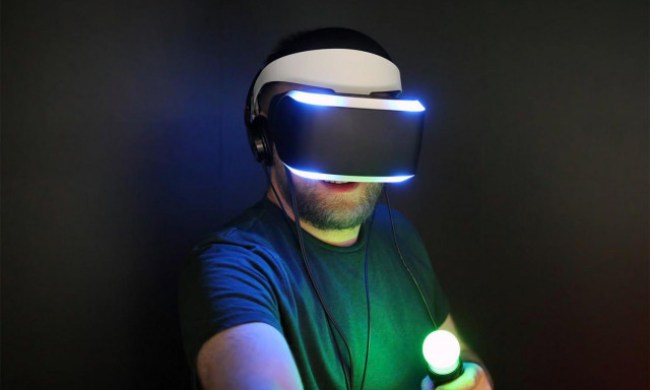The worn, wooden platform underfoot is the first break my chalked, red hands have had in ten minutes. It’s short-lived, however — the rock is calling my name once again. I tentatively lower myself down, pinching a couple of fingers around a small outcropping of rock before shifting my weight over to a wooden beam.
As I reach further out on the beam, it begins to tip, dropping debris and leaves past my face, and it becomes clear my only chance of avoiding a deadly fall is to jump. I do. I leap from the beam to a small lip on the other side of the rock, already marked with streaks of chalk from previous climbers clawing for a grip. But my story, like theirs, ends in tragedy, and I plummet past trees and boulders to certain death in the ocean hundreds of feet below.
The glasses come off, and as if waking from a dream, I find myself standing in the middle of a hotel suite, holding an Xbox One controller.
I’m not hallucinating. I’m playing Crytek’s new VR game The Climb.
What is The Climb?
Some games set out to tell a story, some games create vast worlds, and some games put you behind the wheel of a racecar. Crytek has something different in mind with its newest title, The Climb. It just wants you to free climb a mountain.
That, it turns out, is even harder than it sounds.
Apart from the physical fitness and required equipment, the game demands the same skills as free-climbing. Check the pitch, plan the route, and hold on tight. It even requires you to leap off the rock, or dyno in climbing slang, to reach parts of the rock that are too far away to grab without doing so. These moments are easily the most exciting, because they ask the player to hurl themselves headlong from the relative safety of the wall. For a brief moment, you fly, and if the sweat has worn through the chalk on your hands, you fall.
The Climb really picks up when friends enter into the fray, racing each other for the best times, the fastest routes, and the smoothest dynos. At my demo session, I achieved the highest score yet of press members who had played – and I felt the wave of satisfaction that makes high-score gameplay so addicting. There’s more than a score to chase, however. Like a racing game, the ghost of the fastest time’s hands can be seen grabbing rocks and ledges, giving you a virtual opponent to challenge.
It’s made all the more real by what’s below the action. The postcard-esque ocean of the Southeast Asian stage stretched for miles, interrupted only by other outcroppings that are even more intimidating than the one I was currently stuck to. As I’m reminded while I play, free climbing is all about isolation, on the rock, by yourself, with the beautiful wilderness surrounding you. But it’s hard to take the time to look around, because the feeling of vertigo, the real fear of falling from the wall, is so real.
Why does it matter?
The immersive Oculus Rift headset makes The Climb possible. It just wouldn’t work on a regular display. It’s not just the camera following head movements, or the sweeping vistas the wrap all the way around the player, which make the game. That honor goes to the real feeling of vertigo you get from looking down, the unstable feeling you get from standing on a ledge. This is only possible from a VR headset that can fully fool your senses.
It’s also about the controller. While The Climb supports the Oculus Touch controllers, the Xbox One controller works surprisingly well. Each trigger corresponds to a hand, and the grabbing action quickly becomes tied to the hands in the game. While this obviously has nothing to do with the real act of climbing, it’s intuitive, which makes the control’s presence easy to forget.
Games like The Climb represent VR’s turning point.
The Climb is simple, elegant, and convincing, and it doesn’t need to be anything more than that. Massive role-playing games and immersive shooters will come later. For now, this simple concept is executed with care, and it really shows.
And a big part of making sure that VR survives long enough for that to happen is finding a way to strap headsets to faces. I can tell people how great the Oculus Rift is – and it is, it’s so cool – until I’m blue in the face, but the response is always “sounds neat” until they’ve had a chance to actually try one out. Games like The Climb are the turning point, the type of game that makes skeptics forget it’s a game, and fall in love with VR.
For now, VR technology is about just that — showing people something novel, pushing them to consider the new technology, and asking them to make a leap of faith, grabbing for a crack in the rock in face of the fear of falling to their virtual death.
Highs
- Immersive gameplay
- Intuitive controls
- Beautiful backdrops
Lows
- Terrifying for acrophobics
- Steep mastery curve



